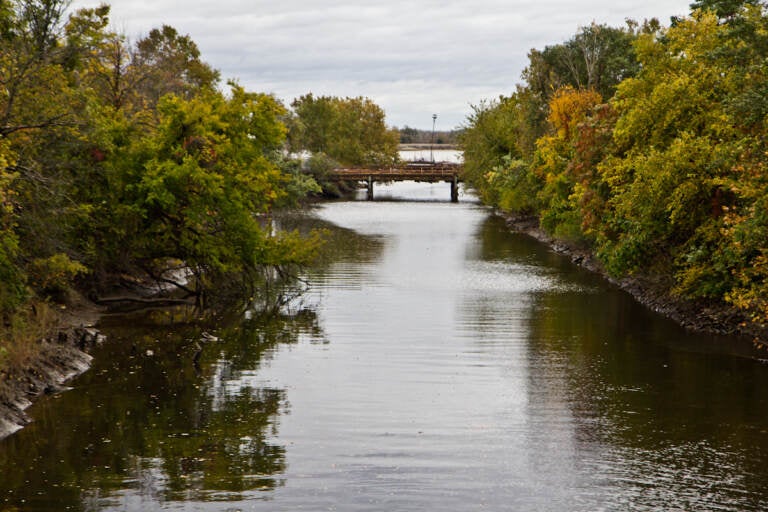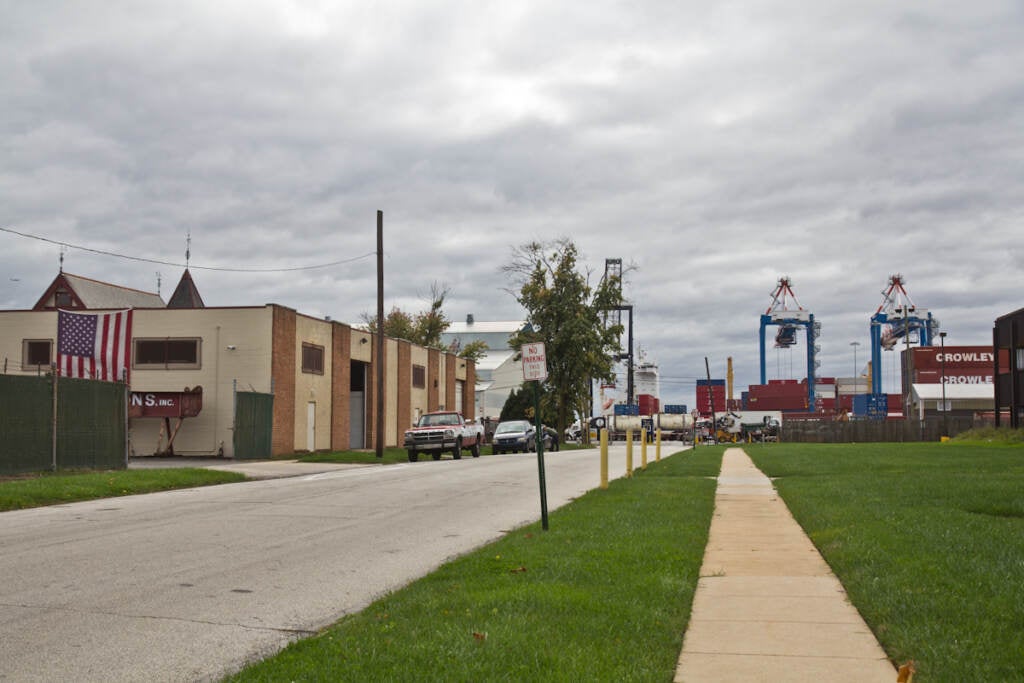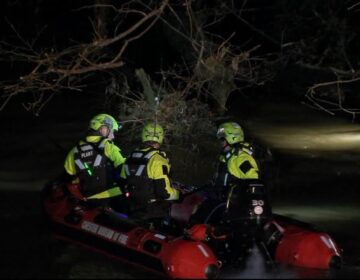Before Salem, Pennsylvania’s first and only witch trial involved a Delco woman
Nine years before the Salem witch trials, the first and only people to stand trial for witchcraft in Pennsylvania were two women from present-day Delaware County.
Listen 4:55
Ridley Creek meets the Delaware River. (Kimberly Paynter/WHYY)
We wrote this story based on contributions from readers and listeners like you. In Montgomery and Delaware counties, what do you wonder about the places, the people, and the culture that you want WHYY to investigate? Let us know here.
For those keeping score of Delco’s quirks at home, they can add a witch trial to the county’s growing list.
The woman who recently shed new light on this little-known gem of Delaware County history is Carla Welsh.
Exhausted and burnt out from working in the medical field, the Springfield resident has developed a new passion digging into Delco history. Equipped with a library card and a knack for public land records research, Welsh recently investigated Pennsylvania’s only witch trial involving a Delco woman — which happened nine years before the infamous Salem witch trials in Massachusetts.

Inspired by a Facebook group, Delaware County PA History, Welsh was determined to find a local tale from the past people would find interesting.
Welsh searched for the word “witch” on NewspaperArchive.com and found a Chester Times article titled “Witches and Their Art in This County” from April 15, 1902 that identified the “Witch of Ridley Creek” as a Swedish settler by the name of Margaret Mattson.
Mattson lived on a farm with her husband, Neels. In 1683, she was accused of bewitching farm animals and “saying strange incantations while boiling meat in a great caulderon,” according to the now-discontinued newspaper.
Mattson wasn’t the only person faced with witchcraft allegations. Another Swedish woman, Yeshro Hendrickson, was also accused.
“I found this pretty interesting because I’ve lived in Delco my whole life and I’ve never heard of this story. So I did a post about it, and my post kind of blew up,” Welsh said.
While the newspaper article laid out many of the facts of the story, Welsh went the extra mile by locating the old Pennsylvania Provincial Council minutes and bringing the case some much-needed context.

She even used FamilySearch.org to find the land records from old Chester County deed books and confirmed that the Mattsons lived in a wooded area by Crum Creek at the edge of the Delaware River in present-day Eddystone Township. The area no longer sports green forests — it’s now an industrial park.
The ‘Witch of Ridley Creek’ goes on trial
Because the colony hadn’t yet established a court system, Mattson was first brought before the council on Feb. 7, 1683, to have her trial set (under the Julian Calendar, February was the 12th month). On Feb. 27, 1683, a grand jury, a petit jury, witnesses, the attorney general, and even then-Gov. William Penn himself filled the courtroom in Philadelphia.
Mattson, who required an interpreter, pleaded not guilty.
Witnesses accused Mattson of a laundry list of transgressions. One man, Henry Drystreet, who was also a member of the jury, said he had heard through the grapevine 20 years prior that Mattson was a witch.
Another man, Charles Ashcom, said Mattson’s own daughter had told him she was a witch. Finally, a woman named Annakey Coolin told the jury Mattson had boiled a calf’s heart after removing it through witchcraft.
Despite not having a lawyer, Mattson delivered a strong defense for each of the allegations, saying that the “witnesses speake only by hear say.”
The jury quickly reconvened and by that afternoon, they had reached a verdict: Mattson was “found guilty of having the common fame of a witch, but not guilty in manner and form of which she stands indicted.”
Her punishment was light. The Mattsons were instructed to pay a fine of 50 pounds apiece and Margaret had to practice good behavior for six months. Yeshro Hendrickson faced the same sentence.
The difference between Puritans and Quakers
The infamous Salem Witch Trials would happen just nine years later in Massachusetts and the results couldn’t have been more different.
Benjamin Ray, a professor emeritus at the University of Virginia, has been researching what happened in Salem for more than 25 years. Just as it did in Delco, the events in Salem and nearby villages also began in the cold grip of February, but in 1692.
“And the form of witchcraft involved here, that is, the type of accusation was spectral, which is unusual, claiming that the specter or image or likeness of the accused was tormenting, choking, attacking painfully the accuser,” Ray said.
Unlike the colony of Pennsylvania, which was established as a safe place for Quakers, the scene in colonial Massachusetts was much different. The villagers in Salem were in constant conflict with the Puritan minister.

When accusations began to fly, a special court convened, trials quickly followed — and mass hysteria ensued. In just nine months, 19 people were hanged, one person was pressed to death with stones, and more than 150 people were jailed.
“The spectral evidence was not seen by anyone, including the judges, but only by the young accusers. Eventually, the ministers in Boston, the church ministers began to object. And when the trials were closed down shortly thereafter, the governor of Massachusetts, William Phipps, said this was a great tragedy, and was a delusion caused by the devil himself,” Ray said.
Ray points to differences in religious tolerance between the Puritans and the Quakers to explain the starkly different outcomes.
Kristine Rabberman, the assistant vice dean and director of academic affairs at the University of Pennsylvania, agrees. For example in the Massachusetts colony, society was built on Puritanism.
“It shaped an entire worldview that was very much built on an idea that there were very strict ways that people should be dressing and should be behaving. And if people were falling outside of those certain behaviors, that would indicate something about the state of their souls, essentially,” Rabberman said.
People who held dissenting views, such as Quakers, often made the decision to move outside of the colony.
In modern times, Americans are used to the idea of a separation of church and state. However, that ideal was absent in Salem. Rabberman, who studied medieval history, finds it quite interesting that Pennsylvania only had one witch trial.
“When you look at how it was resolved, it is a stark difference from Salem. And that also suggests something to me about the fact that the community members, it doesn’t mean they didn’t have tensions with each other, but for whatever series of reasons, those tensions were not emerging in the form of witchcraft accusation,” Rabberman said.
Witchcraft trials, which have roots in Europe, dating back to the 16th and 17th century, often took place during periods of crisis, Rabberman said, including a mini-Ice Age and episodes of crop failure and subsequent famine.
“And for the people who were living in Europe during this period, an explanation that could make sense to them was that this was the devil’s work,” she said. “And that is something that they could use to try to understand things that may be happening to them that were painful.”
Her research has led her to the conclusion that people at the margins of society were often the scapegoat for those in the inner ring of power, especially during times of deep division, fear, and crisis.
And while Salem is the poster child for hysteria, what happened in Pennsylvania offers a different view.
“Now, it’s only one case, so we have to be a little bit careful about over-analyzing, but I do think that looking at examples like that gives us a way of both understanding the range of human responses, and also maybe give some ideas about how we can handle those instances of division and fear within our own societies,” Rabberman said.
As for Welsh, she also thinks the case is important because it shows why everyone deserves a fair trial.
Rediscovering this gem of Delco history has her thinking of turning her passion for historical research into a new career. In the meantime, she is pursuing a more personal project, learning German Kurrent script so that she can read and translate old letters from German family members during World War I.
“I want to engage young people to want to get passionate about learning more and doing their own research,” she said, “because … you can better connect to your community.”

Get daily updates from WHYY News!
WHYY is your source for fact-based, in-depth journalism and information. As a nonprofit organization, we rely on financial support from readers like you. Please give today.







